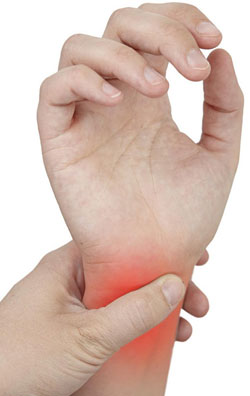
Carpal tunnel syndrome (CTS) is a condition in which patients feel a sensation of tingling, tickling, prickling, pricking, or burning, pain and numbness which runs from the forearm into the palm of the hand. This happens due the compression of median nerve that passes through the Carpal tunnel. Carpal tunnel syndrome affects millions of people each year. It is a type of repetitive disorder and also widely known as median entrapment neuropathy.
Carpal tunnel is a passage on the palmar side of the wrist that connect the forearm to the middle compartment of the deep plane of the palm, made up of tight box of a strong material like flexor, bone and tendons.
Causes
In most of the cases carpel tunnel syndrome are idiopathic. Carpel tunnel syndrome is 3 times more common in women than in men. There are some occupations which lead to carpel tunnel syndrome such as using jack hammer, drilling machines which will give a lot of pressure at the wrist region repeatedly. Recently it was found that typing in the computer for a long time can cause carpel tunnel syndrome. During long hours of typing and use of computer mouse, gives strain to the wrist region which leads to swelling that pinches the median nerve. Carpal tunnel syndrome is sometimes associated with other diseases such as Diabetes, obesity, rheumatoid arthritis, hypothyroidism. Carpel tunnel syndrome is also caused by some medications like oral contraceptives. There are genetic causes such as hereditary neuropathy.
Signs and Symptoms
Carpal tunnel syndrome could involve median nerve in the wrist and hand. As there is a compression, in the median nerve, causes tingling, numbness in the index finger, middle finger and lower half of the ring finger is produced. Upper half of the ring finger and small finger is not involved in the carpal tunnel syndrome. It often starts with tightness and sometimes spasm also occurs in the bicep muscle. There may be tightness or spasm in the forearm of the muscle. In some people when the forearm is starched, the symptom may elevate in the carpal tunnel syndrome.
Diagnosis
Physicians ask patients to take EMG (electromyogram) test. In EMG small electrical shocks are given down the arm and measure how fast the nerve impulse and the electrical activity go down through the hand. There are tests which can be performed by the patient by themselves. This test is called Phalen’s test. In Phalen’s test the wrist has to bend forward to 90 degree. If a person as carpel tunnel syndrome, bending of the wrist will compress the median nerve and produces numbness, pain or feeling of tinkling in thumb, index finger, middle finger and lower half of the ring finger. In Tinel's test, the physician taps the median nerve at the wrist. A tingling response in one or more fingers indicates damage to the median nerve.
Treatment
When symptoms are mild or temporary, treatment includes rest, anti-inflammatory drugs, and supported with wrist splint. Even while wearing a splint, activities that can aggravate the injury have to be avoided. If this is not possible, patients should wear the splint after work and particularly during sleeping hours.
Specific exercises supervised by a physical or occupational therapist and yoga can be beneficial.
If all the alternative treatment measures do not provide any relief then, Carpal tunnel release surgery is recommended. In this surgery the compression of the nerve and tendons that run through the carpal tunnel is released by making more space through the ligament. Surgery usually will be the last choice of treatment.
Prevention
Prevention of carpal tunnel syndrome may involve redesigning work stations, tools, or the job, and educating workers. Proper work station design reduces awkward wrist positions and minimizes the stressful effects of repetitive motions.
Good job design minimizes awkward wrist positions and tasks with repetitive motions. Job design includes the following:
1) analysis of the sequence of the tasks to allow changes in body position
2) work-rest schedule to relieve muscles from mechanical stress
3) work breaks to avoid monotonous and repetitive patterns of work
4) rotation of tasks to move workers from one job to another
Worker training should aim to reduce the number and types of awkward wrist postures and the number of repetitive motions. Informing workers about the risk factors that can contribute to carpal tunnel syndrome is important.
To limit the effects of a physically stressful job, employers should work closely with employees. This is achieved by implementing worker training and job rotation, and by matching employees to job assignments.





